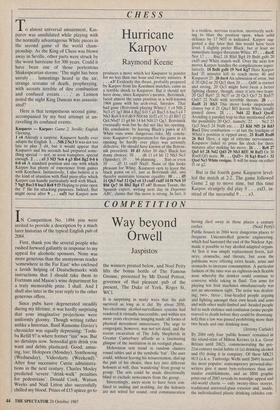CHESS
Hurricane Karpov
Raymond Keene
To almost universal amazement, Kas- parov was annihilated while playing with the normally advantageous White pieces in the second game of the world cham- pionship. As the King of Chess was blown away in Seville, other parts were struck by the worst hurricane for 300 years. Could it have been one of those portentous Shakespearian storms: 'The night has been unruly . . . lamentings heard in the air, strange screams of death, prophesying, with accents terrible of dire combustion and confused events . . . ,' as Lennox noted the night King Duncan was assassin- ated?
Here is that tempestuous second game, accompanied by my best attempt at un- ravelling its confused events:
Kasparov — Karpov: Game 2, Seville; English Opening, 1 c4 Already a surprise. Kasparov hardly ever adopts the English. I. . .Nf6 2 Nc3 It was not too late to play 2 d4, but it would appear that Kasparov and his seconds had prepared some- thing special -- not, as soon transpires, special enough. 2 . . . e5 3 Nf3 Nc6 4 g3 Bb4 Bg2 0-0 6 0-0 e4 A standard position and one with which Karpov has plenty of experience from games with Korchnoi. Instinctively, I also believe it is the kind of situation with fluid piece-play which Karpov can handle particularly well with Black. 7 Ng5 Bxc3 8 bxc3 Re8 9 f3 Hoping to prise open the 'f' file for attacking purposes. Indeed, that might occur after 9 . . . exf3 but Karpov now produces a move which led Kasparov to ponder for no less than one hour and twenty minutes. 9 . . . e3! Evidently this thrust, probably prepared by Karpov from his Korchnoi matches, came as a terrible shock to Kasparov. But it should not have done, since Kasparov's mentor, Botvinnik, faced almost the same position in a well-known 1964 game with his arch-rival, Smyslov. That had gone (Botvinnik playing White): 1 c4 Nf6 2 Nc3 e5 3g3 B64 4 Bg2 0-0 5 a3 Bxc3 6 bxc3 e4 7 Nh3 Re8 8 0-0 d6 9 Nf4 b6 10 f3 e3! 11 d3 Bb7 12 Qel Nbd7 13 g4 h6 14 h4 Nf8 15 Qg3. Botvinnik eventually won but he did not like his opening. His conclusion: by leaving Black's pawn at e3 White runs some dangerous risks. My conclu- sion: Kasparov's preparation for this game in an opening he hardly ever plays was seriously defective. He should have known of the Botvin- nik precedent. 10 d3 After 10 dxe3 Black has many choices: 10 . . . d6 11 e4 h6 12 Nh3 Ne5 (Spassky); 10 . . . b6 planning . . . Ba6 or even 10 . . . d5 11 cxd5 Nxd5. None of this looks pleasant for White. Kasparov opts to leave the black pawn on e3, just as Botvinnik did, ana thereby maintains tenuous equality. 10 . . . d5 11 Qb3 Na5 12 Qa3 c6 13 cxd5 cxd5 14 f4 Nc6 15 Rbl Qc7 16 Bbl Bg4 17 c4? Roman Toran, the Spanish expert, writing next day in Deportes ABC, claims that this move is strong. In fact, it
is a restless, nervous reaction, incorrectly seek- ing to blast the position open, when solid defence by 17 Nf3! is indicated. Karpov sug- gested a day later that this would have been level. I slightly prefer Black, but at least no immediate danger threatens White. 17 . . . dxc4! Not 17 . . . Bxe2 18 Rfel Bg4 19 Bxf6 gxf6 20 cxd5 and White stands well. Over the next few moves Karpov handles the complications super- latively. 18 Bxf6 gxf6 19 Ne4 Kg7 Here Karpov had 35 minutes left to reach move 40 and Kasparov 25.,20 dxc4 An admission of error, but if 20 Qb2 or 20 Qc3 then 20 . . . Qd8! is correct and strong. 20 Qc3 might have been a better fighting chance, though, since it sets two traps: 20 Qc3 Re6? 21 Nc5! or 20 Qc3 Qe7 21 Rxb7! Qxb7 22 Nxf6 with terrrible threats. 20 . Rad8 21 Rb3 This move looks suspiciously clumsy but if 21 Qxe3 Bf5 leaves White totally pinned down. 21 . . . Nd4 22 Rxe3 Qxc4! Avoiding a parallel trap to that mentioned after the possibility 20 Qc3, namely, 22 . . . Nc2 23 Qc3 Nxe3 24 Nxf6 etc. . . 23 Khl Nf5 24 Rd3 Bxe2 Dire combustion — at last the lynchpin of White's position is ripped away. 25 Rxd8 Rxd8 26 Rel Here, a sign of extreme nervousness, Kasparov failed to press his clock for three minutes after making his move. 26 . . . Re8 27 Qa5 b5 28 Nd2 Qd3 29 Nb3 Bf3! 30 Bxf3 Or 30 Rxe8 Qfl mate. 30 . . . Qxf3+ 31 Kg1 Rxel+ 32 Qxel Ne3 White resigns. It will be mate on either fl or g2.
But in the fourth game Kasparov level- led the match at 2-2. The game followed Game 2 up to move nine, but this time Karpov strangely did play 9 . . . exf3, in- stead of the successful 9 . . . e3.


















































 Previous page
Previous page